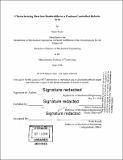| dc.contributor.advisor | Alberto Rodriguez. | en_US |
| dc.contributor.author | Gano, Selam | en_US |
| dc.contributor.other | Massachusetts Institute of Technology. Department of Mechanical Engineering. | en_US |
| dc.date.accessioned | 2019-01-11T16:05:20Z | |
| dc.date.available | 2019-01-11T16:05:20Z | |
| dc.date.copyright | 2018 | en_US |
| dc.date.issued | 2018 | en_US |
| dc.identifier.uri | http://hdl.handle.net/1721.1/119957 | |
| dc.description | Thesis: S.B., Massachusetts Institute of Technology, Department of Mechanical Engineering, 2018. | en_US |
| dc.description | Cataloged from PDF version of thesis. | en_US |
| dc.description | Includes bibliographical references (page 11). | en_US |
| dc.description.abstract | Position-controlled robotic manipulators remain an industry standard but are ill-suited for guarded move approaches to advanced manipulation. Adding additional feedback with the expectation that a position-controlled system can account for it cannot guarantee successful implementation. To explore and define the limitations of position-controlled arms, I attempt to characterize different motion and force bandwidths of a large, 6-DOF robotic arm. Peak force and motion overshoot measurements were taken at varying speeds of the robot. These experiments showed that at speeds as low as 10 mm/s, the robot still exerted over 40 Newtons of force, enough to crush objects typically used for manipulation tasks. Overcoming these issues in using position-controlled arms are difficult to account for with software approaches, but different mechanical solutions can be envisioned to combat this problem in robotic manipulation. | en_US |
| dc.description.statementofresponsibility | by Selam Gano. | en_US |
| dc.format.extent | 11 pages | en_US |
| dc.language.iso | eng | en_US |
| dc.publisher | Massachusetts Institute of Technology | en_US |
| dc.rights | MIT theses are protected by copyright. They may be viewed, downloaded, or printed from this source but further reproduction or distribution in any format is prohibited without written permission. | en_US |
| dc.rights.uri | http://dspace.mit.edu/handle/1721.1/7582 | en_US |
| dc.subject | Mechanical Engineering. | en_US |
| dc.title | Characterizing reaction bandwidths in a position-controlled robotic arm | en_US |
| dc.type | Thesis | en_US |
| dc.description.degree | S.B. | en_US |
| dc.contributor.department | Massachusetts Institute of Technology. Department of Mechanical Engineering | |
| dc.identifier.oclc | 1080343047 | en_US |
